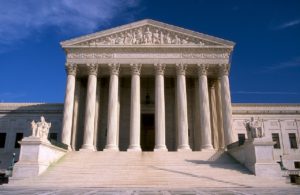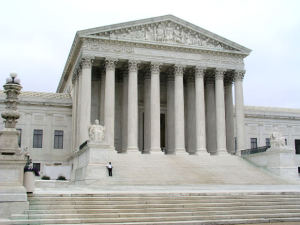By Elizabeth Sargeant
The Constitution protects each of us from unreasonable searches and seizures.[1] Police officers may not enter our homes without a warrant issued by a neutral magistrate on a showing of probable cause.[2] This procedural safeguard may be overlooked, however, when exigent circumstances arise and make a warrantless search reasonable.[3] Exigent circumstances include emergency, hot pursuit, and destruction of evidence.[4] An exception to the exigent circumstances rule precludes its use to justify a warrantless search when the officers themselves created the exigency.[5]
While courts agree that police-created exigencies do not fall within the exigent circumstances rule, lower federal and state courts have developed a number of tests to determine in what circumstances and in what sense police impermissibly create an exigency. Some factors the courts consider include the subjective intentions of the officers, the opportunity to obtain a warrant, the reasonableness of the investigative tactics, whether police actions violated any laws, and the degree to which it was foreseeable that their actions would create an exigency.[6]
The Supreme Court settled a circuit split on exigent circumstances cases in Kentucky v. King, holding that “the exigent circumstances rule applies when the police do not gain entry to the premises by means of an actual or threatened violation of the Fourth Amendment.”[7] This decision will significantly impact claims brought under the Federal Constitution. The King test makes it more difficult for courts to invalidate those warrantless searches justified by the exigent circumstances rule. Fewer searches will be found unreasonable in post-hoc evaluations. Police in the field will have the discretion to enter a home without a warrant whenever they suspect that evidence is being destroyed, regardless of whether their conduct effectively led to the exigency, unless they violated the Fourth Amendment before the exigency arose.
This Note will focus on the proper test for determining when law enforcement agents impermissibly create exigent circumstances. Part I will provide the factual and procedural background of the King case as well as the Court’s holding and its reasoning. Part II will explain the Fourth Amendment and what it requires, and will briefly touch on the historical need for its protections. It will discuss the exigent circumstances rule, when it may be used, and the one exception to that rule—the police-created exigency restriction. It will describe the tests used to determine when an exigency is police created. Finally, Part III will look to the future and evaluate the exigent circumstances rule in light of the King decision. It will then provide an alternative solution better suited to the problem than the King test.
I. The Case: Kentucky v. King
A. The Facts
The facts of the King case differ from the typical “knock, announce, hear movement behind the door, and enter without a warrant” fact pattern of most exigent circumstances cases. The situation began when police set up a controlled sale of crack cocaine outside the apartment complex where the defendant, Hollis King, lived.[8] For clarity, it should be noted that the controlled sale involved a suspect and transaction entirely unrelated to King. After the sale, an observing officer radioed to other nearby officers to “move in on the suspect.”[9] He noted that the suspect was “moving quickly toward the breezeway of an apartment building”[10] and told them to hurry.[11] As the officers arrived at the breezeway, they heard one of the rear apartment doors shut but did not see which door the suspect entered.[12] They noticed a strong odor of marijuana issuing from the left rear apartment, which led them to believe that the door had recently been opened and shut and that the suspect had entered that apartment.[13] The officers knocked on this door and identified themselves as police.[14] After the knock, they heard things being moved around inside.[15] Believing that the people inside were in the process of destroying evidence, the officers entered the apartment.[16] The officers found the defendant and two others but not the suspect of their pursuit.[17] One of the individuals in the apartment with King was smoking marijuana.[18] While conducting a protective sweep of the apartment, officers found marijuana and cocaine in plain view.[19]
King was charged with trafficking a controlled substance, possession of marijuana, and being a persistent felony offender.[20] The trial court denied his motion to suppress the evidence found during the warrantless search on the basis that exigent circumstances justified the warrantless entry.[21] King appealed the denial of his motion to suppress, arguing that the search of his apartment was “conducted in violation of the Fourth Amendment to the United States Constitution because it was unsupported by probable cause and an exigent circumstance.”[22] The state intermediate appellate court affirmed the ruling of the trial court.[23]
B. The Kentucky Supreme Court Decision
The Kentucky Supreme Court reversed, finding that the police created the exigent circumstances on which they relied to justify the search.[24] In reaching this conclusion, the court determined that it was reasonably foreseeable that “knocking on the apartment door and announcing ‘police’ after having smelled marijuana emanating from the apartment, would create the exigent circumstance relied upon, i.e. destruction of evidence.”[25] The court further noted that when police “unnecessarily announce their presence, and this creates the fear that evidence will be destroyed, police have created their own exigency, and cannot rely on the fear of evidence being destroyed as a justification for a warrantless entry.”[26]
C. The Supreme Court Decision
1. The Majority Opinion
The Supreme Court granted the Commonwealth’s petition for certiorari[27] and reversed the decision of the Kentucky Supreme Court.[28] The Court held that “the exigent circumstances rule applies when the police do not gain entry to [the] premises by means of an actual or threatened violation of the Fourth Amendment.”[29] Explaining its reasoning, the Court stated that “warrantless searches are allowed when the circumstances make it reasonable, within the meaning of the Fourth Amendment.”[30] It follows that exigent circumstances are sufficient justification for a warrantless search “when the conduct of the police preceding the exigency is reasonable in the same sense.”[31] The Court defined police actions as reasonable when the officers do not “engag[e] or threaten[] to engage in conduct that violates the Fourth Amendment.”[32]
Applied to the facts, the Court found “no evidence that the officers either violated the Fourth Amendment or threatened to do so prior to the point when they entered the apartment.”[33] Therefore, their conduct was “entirely consistent with the Fourth Amendment,”[34] and the exigent circumstances rule applied. Accordingly, the Court reversed the Kentucky Supreme Court’s decision.[35]
2. The Dissenting Opinion
Justice Ginsburg, the lone dissenter, opposed the majority’s adoption of such a lenient standard. She called the decision a “reduction of the Fourth Amendment’s force”[36] and believed that the decision would provide officers with a way to routinely dishonor the warrant requirement in drug cases.[37] Justice Ginsburg framed the issue as whether “police, who could pause to gain the approval of a neutral magistrate, [may] dispense with the need to get a warrant by themselves creating exigent circumstances[.]”[38] She answered no and argued that the exigency must exist when law enforcement officers arrive at the scene, rather than afterwards as a result of their own conduct.[39]
Justice Ginsburg reminded the Court that the police bear the burden of proving an emergency to justify a warrantless search.[40] She argued that Kentucky failed to meet this burden because nothing in the record indicated that the occupants were concerned about police proximity prior to the officers’ knock and announce.[41] Since drug possessors generally do not destroy their drugs absent fear of discovery, it was unlikely that evidence would have been destroyed while the police sought a warrant.[42] Further, according to Justice Ginsburg and the Kentucky Supreme Court, the police had probable cause to obtain a warrant.[43] “Wasting a clear opportunity to obtain a warrant . . . disentitles the officer from relying on subsequent exigent circumstances.”[44] Therefore, there was “no reason to contract the Fourth Amendment’s dominion.”[45]
3. A Note Regarding Federalism
It is important to note that a Fourth Amendment challenge is not the only argument a suspect can assert as a defense against warrantless searches. In every state constitution, there is a protection analogous to the Fourth Amendment in the Federal Constitution.[46] A suspect may raise a state constitutional challenge as well as a federal constitutional challenge when he believes his rights are violated.[47] The Supreme Court’s test and reasoning in King apply only to interpretations of Fourth Amendment rights. State courts are free to grant more protection to their citizens by interpreting their state constitutions differently. Therefore, while the Court’s test must be applied to Fourth Amendment challenges and is a persuasive authority for state courts to follow, these other courts are not required to follow the King test when evaluating claims under state constitutions.
II. Fourth Amendment Jurisprudence and the
Exigent Circumstances Rule
A. The Fourth Amendment and What It Requires
The exigent circumstances rule would be unnecessary if not for the Fourth Amendment. It states:
The right of the people to be secure in their persons, houses, papers, and effects, against unreasonable searches and seizures, shall not be violated, and no Warrants shall issue, but upon probable cause, supported by Oath or affirmation, and particularly describing the place to be searched, and the persons or things to be seized.”[48]
This text creates a constitutional mandate that “all searches and seizures . . . be reasonable.”[49]
The text of the Fourth Amendment speaks not only to the reasonableness of searches but also to the need for warrants and what is required to obtain a warrant. Though not stated in the text, the Supreme Court has inferred from this language the requirement that “a warrant must generally be secured.”[50] “It is a cardinal rule that, in seizing goods and articles, law enforcement agents must secure and use search warrants wherever reasonably practicable.”[51] When a warrant is required, it must be based on probable cause, supported by a sworn affidavit,[52] and issued by a “neutral and detached”[53] magistrate. The affidavit must “describe[] particularly the place of the search”[54] and the “type of evidence sought.”[55]
Along with the text, it is important to consider the historical backdrop of the Fourth Amendment. The Court has noted that the Fourth Amendment “was a reaction to the evils of the use of the general warrant in England and the writs of assistance in the Colonies, and was intended to protect against invasions of ‘the sanctity of a man’s home and the privacies of life’ from searches under indiscriminate, general authority.”[56] General warrants were notoriously used in eighteenth-century England against critics of the government.[57] General warrants did not specify the place to be searched or the items to be seized.[58] Writs of assistance, used during the American colonial period, similarly authorized English customs agents to search private premises without specifying where to search or what could be seized.[59] In reaction to these abuses of power, “[p]rotection [from invasions into one’s home] was assured by prohibiting all ‘unreasonable’ searches and seizures, and by requiring the use of warrants.”[60] This principle that the home was especially sacred and needed protection from government intrusion is reflected in Lord Camden’s oft-quoted assertion that “the great end, for which men entered into society, was to secure their property.”[61]
B. The Exigent Circumstances Rule
As this history demonstrates, “[i]t is a ‘basic principle of Fourth Amendment law’ that searches and seizures inside a home without a warrant are presumptively unreasonable.”[62] The Court has emphasized that “the Fourth Amendment . . . draw[s] a firm line at the entrance to the house. Absent exigent circumstances, that threshold may not reasonably be crossed without a warrant.”[63] Accordingly, if exigent circumstances do exist, law enforcement officers may cross this threshold and enter a residence without a warrant. This is known as the exigent circumstances rule, which the Court in King described as a “well-recognized exception” that applies when “the exigencies of the situation make the needs of law enforcement so compelling that a warrantless search is objectively reasonable under the Fourth Amendment.”[64]
To determine whether exigent circumstances exist, courts look to a number of factors. The most widely accepted list of factors was enumerated by the D.C. Circuit in Dorman v. United States[65] and summarized by the Second Circuit in United States v. MacDonald.[66] The factors include the gravity of the offense, whether the suspect is armed, whether the officers have probable cause to believe that the suspect committed the crime and “strong reason to believe”[67] that the suspect is inside the premises, the “likelihood that the suspect will escape if not swiftly apprehended,”[68] and “the peaceful circumstances of the entry.”[69] The first factor, the gravity of the offense, is especially important, as it has been endorsed by the Supreme Court.[70]
Once courts establish that an exigency did in fact arise, the exigent circumstances rule applies. This rule is a constitutionally permissible exception to the warrant requirement because “the ultimate touchstone of the Fourth Amendment is ‘reasonableness.’”[71] Thus, “[w]here there are exigent circumstances in which police action literally must be ‘now or never’ to preserve the evidence of the crime, it is reasonable to permit action without prior judicial evaluation.”[72] Therefore, the exigent circumstances rule is constitutional because the warrantless searches it permits are not unreasonable within the meaning of the Fourth Amendment.
Turning to King, the exigent circumstance at issue was “the need to ‘prevent the imminent destruction of evidence.’”[73] The Court has acknowledged two other situations that trigger the exigent circumstances rule: when an officer is responding to an emergency and when an officer is in “hot pursuit of a fleeing felon.”[74] Neither of these circumstances arose in King, so this Note will focus only on the imminent destruction of evidence.[75]
This exigency often arises when police use the knock-and-talk investigative technique. A knock-and-talk occurs when an officer knocks on the door of a residence, identifies himself as a police officer, and asks to speak with the occupants. Such encounters between the police and residents of a home are not considered searches or seizures within the meaning of the Fourth Amendment.[76] Nor is there a constitutional issue with officers waiting to obtain a warrant.[77] In King, the Court ruled that there exist a number of valid reasons as to why an officer might wish to conduct a knock-and-talk rather than obtain a warrant.[78]
C. The Restriction on Police-Created Exigencies
With the widespread use of the knock-and-talk comes the potential for abuse. “The tactic can create exigent circumstances, resulting in illegal searches and seizures, when an occupant reacts to police presence with more than a mere grant or denial of consent to search.”[79] One method of curbing potential abuse of the knock-and-talk technique is the restriction on the use of police-created exigent circumstances to justify subsequent warrantless searches. “[P]olice may not rely on the need to prevent destruction of evidence when that exigency was ‘created’ or ‘manufactured’ by the conduct of the police.”[80]
That the conduct of police has created the exigency, however, is not the end of the analysis. The inquiry does not end with this simple question because “in some sense the police always create the exigent circumstances that justify warrantless entries and arrests.”[81] What exactly the inquiry should focus on is a difficult question and was at issue before the Court in King. As the Court noted, “[T]he lower courts have held that the police-created exigency doctrine requires more than simple causation, but [they] have not agreed on the test to be applied.”[82] These tests include the “lawful manner” test, the “bad faith” test, the “reasonable foreseeability” test, the “standard or good investigative tactics” test, and the “probable cause and time to secure a warrant” test.[83] Other scholars have named these tests according to the circuit in which they originated or by placing the tests into a few general categories.[84] This Note follows the approach used by the Court in King to identify the different tests used by lower courts.
D. The Tests for Determining When an Exigency is Police Created
1. Lawful Manner
The lawful manner test is most closely aligned with the Court’s eventual holding in King. In King, the Court mentioned two cases that employed the lawful manner test: United States v. MacDonald[85] and State v. Robinson.[86] In MacDonald, a knock-and-talk drug case, the Second Circuit held that “when law enforcement agents act in an entirely lawful manner, they do not impermissibly create exigent circumstances.”[87] The court noted that the most important factor in its decision was that “the agents’ conduct was perfectly proper. By knocking and announcing themselves, they acted in accordance with the law.”[88] The underlying belief of those who advocate the use of this test is that the suspect’s reaction, “attempting to escape, destroy evidence, or engage in any other unlawful activity,”[89] is what creates the exigency, not the officer’s conduct. This is so even though “the suspects may reasonably be expected to behave illegally.”[90] In Robinson, the Wisconsin Supreme Court reasoned similarly, stating that “[i]t was not the officers’ knock and announcement that created the exigent circumstances . . . . Rather, [the suspect’s] choice to run from the door created the exigent circumstances that justified the officers’ warrantless entry.”[91] Thus, the lawful manner test holds that when an officer’s conduct conforms to the law, he does not create the exigent circumstance, and the exigent circumstances rule applies.
The lawful manner test has been criticized by Supreme Court Justice Ginsburg as “arm[ing] the police with a way routinely to dishonor the Fourth Amendment’s warrant requirement in drug cases.”[92] A Second Circuit judge similarly criticized this test for “effectively creat[ing] a situation in which the police have no reason to obtain a warrant when they want to search a home with any type of connection to drugs.”[93] Another commentator noted that such a test “seems totally unmoored from the purpose of the exigent circumstances exception.”[94] The purpose of the restriction on police-created exigencies “is to recognize that [they] are not true exigencies. If the police opt to do the thing that creates the emergency, then there was no genuine emergency.”[95]
Regardless of these concerns, the Supreme Court ruled in favor of a very similar test. It emphasized that its conclusion “follows directly and clearly from the principle that permits warrantless searches in the first place,”[96]—that warrantless searches must be reasonable. Put another way, “the exigent circumstances rule justifies a warrantless search when the conduct of the police preceding the exigency is reasonable”[97] within the meaning of the Fourth Amendment. Thus, under this rule, so long as officers’ conduct does not violate the Fourth Amendment, they have not created the exigent circumstances.[98]
2. Bad Faith
The bad faith test looks to the subjective intentions of the officers to determine if the exigency was police created.[99] Courts in the First, Fifth, Sixth, and D.C. Circuits all consider the intentions of the officer in their police-created exigency calculus.[100] This test asks “whether the officers deliberately created the exigent circumstances with the bad faith intent to avoid the warrant requirement.”[101] The officers’ underlying purpose cannot be to subvert the warrant requirement, and officers may not manufacture a situation for the purpose of creating an exigency.[102] The result is that “exigent circumstances do not excuse [a warrantless search] when those circumstances are created by [a] . . . deliberate[] delay [in] obtaining a warrant.”[103]
The bad faith test has been heavily criticized as “fundamentally inconsistent with our Fourth Amendment jurisprudence.”[104] Furthermore, it is often difficult for courts, on a post-hoc basis, “to precisely determine what an officer intended to accomplish.”[105] Most critically, the subjective intentions of the officers “do not force a suspect to respond to a knock-and-talk by destroying evidence or otherwise creating an exigency.”[106] Indeed, in a number of jurisdictions that consider the subjective intentions of the officers, it is only one factor in a multipart test to determine whether the police created the exigency. The Fifth Circuit uses a test that involves both a subjective component and a reasonableness inquiry.[107] Similarly, the Sixth Circuit uses other factors like the existence of probable cause and the opportunity to secure a warrant in evaluating officers’ subjective intentions.[108]
3. Reasonable Foreseeability
When considering whether an exigency was created by police, the reasonable foreseeability test asks “whether the danger of destruction of the evidence was reasonably foreseeable” given the officers’ pre-exigency conduct.[109] Subjective intent is irrelevant because the focus is on the likely result of an officer’s conduct. In the context of a controlled sale of drugs, the Arkansas Supreme Court in Mann v. State explained that the officers “reasonably could have foreseen that their decision to approach [Defendant’s] residence without a warrant immediately after completing a controlled delivery of methamphetamine would likely result in an attempt to destroy the evidence.”[110]
The Court in King rejected this test because it would lead to an “unacceptable degree of unpredictability.”[111] The dissent in Mann likewise refused to endorse this test. It faulted the test for failing to recognize that the suspect, not the officers, creates the exigency that leads to a warrantless search.[112]
Nevertheless, courts that employ this test ask “whether, regardless of good faith, it was reasonably foreseeable that the investigative tactics employed by the police would create the exigent circumstances relied upon to justify a warrantless entry.”[113]
4. Standard or Good Investigative Tactics
A similar test considers the propriety of the investigative technique itself, rather than the foreseeability that an exigency will arise from an officer’s chosen tactic. The standard or good investigative tactics test focuses on how the exigent circumstance arose. The test is an “antecedent inquiry,” says the Eighth Circuit, “into the reasonableness and propriety of the investigative tactics that generated the exigency.”[114] The Fifth Circuit also uses this test as part of its two-pronged analysis. In Gould, the court explained that the first focus is on the subjective intentions of the officers.[115] Bad faith is sufficient but not necessary for the court to find that the exigency was impermissibly created by police. If the court does not find a showing of bad faith, it then asks “whether [the officers’] actions creating the exigency were sufficiently unreasonable or improper as to preclude dispensation with the warrant requirement.”[116] The court requires that the tactics or procedures followed by officers be reasonable and in conformity with standard or good law enforcement practices in order to use the exigent circumstances rule.[117]
In King, the Court faulted this test for failing to provide clear guidance to officers on the scene and for permitting courts to make “judgments on matters that are the province of . . . law enforcement agencies.”[118]
5. Probable Cause and Time to Secure a Warrant
Another test considers “whether the police had the opportunity to seek a warrant.”[119] It appears that this is only a factor that courts consider and not a dispositive test. However, for courts that look to the foreseeability or reasonableness of police tactics, the opportunity to secure a warrant is often an important factor. In Mann, the Arkansas Supreme Court quoted Fourth Amendment scholar Wayne LaFave: “[I]n cases where police did not avail themselves of an earlier opportunity to get a warrant, this has been a dominant factor in the holdings that there were not exigent circumstances.”[120] This is logical given that the “entire justification for the exigent-circumstances exception to the warrant requirement is the urgency of the situation. . . . Clearly, if officers have the opportunity to seek a warrant, the situation is not one of urgency.”[121] The Mann court stated emphatically:
[W]here the police, with ample probable cause, time to obtain a warrant, and time for reflection, choose to pursue a course of action which they know at the outset will present a situation requiring an emergency entrance into a person’s home, we hold that they should obtain a warrant and that they may not rely on the expected exigency to justify their entry.[122]
Using this test, some courts have identified other investigative tactics that would avoid warrantless searches. For example, in Mann, the court noted that officers in the position to make a knock-and-talk after a controlled sale have two better alternatives: continue surveillance while an officer leaves to secure a search warrant or obtain an anticipatory search warrant prior to the controlled delivery.[123]
The Court in King, however, rejected this test and these alternatives because “[t]here are many entirely proper reasons why police may not want to seek a search warrant as soon as the bare minimum of evidence needed to establish probable cause is acquired.”[124] For example, the police may want to speak to occupants simply to glean more information before deciding to obtain a warrant. Alternatively, officers may engage in a knock-and-talk in hopes of obtaining consent to search “because doing so is simpler, faster, and less burdensome than applying for a warrant.”[125] The Court emphatically restated its opinion from Hoffa v. United States[126] that “[l]aw enforcement officers are under no constitutional duty to call a halt to a criminal investigation the moment they have the minimum evidence to establish probable cause.”[127]
Thus, this test, like the others, has both benefits and potential pitfalls. While the use of this test may offer insight into whether officers acted in bad faith or whether their tactics were improper, there are a number of lawful reasons officers might fail to secure a warrant in the face of probable cause.
6. The King Test
In King, the defendant argued for a new test that would prevent officers from using the exigent circumstances rule when they “engage in conduct that would cause a reasonable person to believe that entry is imminent and inevitable.”[128] He argued that factors such as an officer’s volume and tone of voice as well as the forcefulness of his knock should contribute to the determination.[129] The Court summarily dismissed his suggestion. It emphasized that “the ability of law enforcement officials to respond to an exigency cannot turn on such subtleties”[130] and noted that a forceful knock or loud voice is often necessary to properly announce and identify their presence.[131]
III. The Future of the Exigent Circumstances Rule
After King, and an Alternative
The Supreme Court faced a very tricky issue in King. Blogger Orin Kerr perfectly captured this dilemma:
How do you distinguish police-created exigent circumstances from suspect-created exigent circumstances? On one hand, you don’t want to make it easy for the police to circumvent the warrant requirement. On the other hand, you don’t want the police to be unable to rely on genuine exigencies created by their innocuous conduct. The question is, what test can achieve both goals at once?[132]
While the Court did not address this dichotomy, the structure and content of its decision shows that it, too, felt the great challenge this case presented. The Court chose the test it thought best achieved these goals: the lawful manner test, refined to address criticisms that this test did not properly delineate what lawful conduct meant. The Court ultimately felt that any conduct that does not violate the Fourth Amendment is lawful and does not create the exigent circumstance. The next part of the Court’s decision addressed the rejected tests, explaining the problems associated with each test. This suggests that the Court knew its test was not a perfect solution to every theoretical and practical problem proposed but wanted to show why the other tests were less preferable.
The Court tackled this problem with a grand effort. For the most part, its criticisms of the other tests were well founded and persuasive. The Court failed, however, to actually acknowledge the obvious problems with the test it chose. Because of the problematic implications of the King test, I propose a new test that would provide a better solution to determine what makes a police-created exigency.
A. The Future of the Exigent Circumstances Rule
First, consider why the Supreme Court’s chosen solution fails. One must only look as far as the King dissent to begin to see the problem. Justice Ginsburg criticizes the majority for “arm[ing] the police with a way routinely to dishonor the Fourth Amendment’s warrant requirement in drug cases.”[133] These powerful words explain the most troubling aspect of the Court’s decision: it will absolutely cripple the warrant requirement in the context of drug cases.
One unique thing about drugs, as evidence, is that they are small and easily disposed of. Thus, the principal evidence in a drug investigation can be destroyed immediately by flushing it down the toilet while police wait at the door. Because of this potential for destruction, officers often express concern that evidence is in imminent danger of destruction. The King test provides officers with the ability to break in while a suspect attempts to destroy evidence, so long as the officers do not engage in, or threaten to engage in, conduct that violates the Fourth Amendment. Put another way, officers are permitted to engage in any conduct that does not violate the Fourth Amendment in order to manufacture a situation in which they hope, or even expect, the suspect will respond by destroying evidence. Why would an officer, in investigating a drug case, seek a warrant when he could conduct a search by knocking on the door and entering when the suspect failed to answer right away? In short, he would not seek a warrant. As per the Supreme Court’s decision, this situation is acceptable. Therefore, Justice Ginsburg is quite right when she states that the decision provides officers with a way to dishonor the warrant requirement in drug cases.
The King test is also problematic because the line it draws is arbitrary and unrelated to the reason the line is needed.[134] Fourth Amendment jurisprudence draws a line, for purposes of the exigent circumstances rule, between exigencies that arise naturally before the officers’ actions and those that occur as a result of police conduct. The purpose of this line is to weed out true exigencies from situations that could have been avoided. A test that only requires that police conduct conform to the Fourth Amendment does not distinguish when an exigency is police created. Rather, it suggests that even if the situation is manufactured by police, it is permissible unless police conduct violates the Fourth Amendment. Rather than recognizing true exigencies and protecting an officer’s ability to respond to them, the King test allows police to effectively manufacture an exigency but does not label it police created, thus allowing officers to rely on it to conduct a warrantless search. Because the line the King test draws is divorced from the purpose of the police-created exigency exception, it is not the proper test.
After King, in the context of drug cases, the exigent circumstances rule may be used without restriction to justify a warrantless search whenever police believe evidence is being destroyed. There is no need to secure a warrant because the officers are permitted to manufacture a situation in which the suspect is expected to destroy evidence. In these circumstances, the officers now have the Court-sanctioned ability to break into the premises without a warrant. Just as Justice Ginsburg predicted, in the post-King world of criminal procedure, law enforcement agents will be able to regularly disregard the Fourth Amendment in drug cases.
B. An Alternative: The Foreseeability Plus Probable Cause Test
I propose an alternative test—the foreseeability plus probable cause test. In this two-part conjunctive test, police impermissibly create exigent circumstances when two elements are present: first, when it is reasonably foreseeable that the officers’ actions will lead to an exigency, and second, when the officers have both probable cause and time to obtain a warrant. Initially, this test looks very similar to the test used by the Arkansas Supreme Court in Mann v. State.[135] There are subtle differences, however, that make this test more tenable than the one adopted in Mann. There, the court announced the test as “[w]hether, regardless of good faith, it was reasonably foreseeable that the investigative tactics employed by the police would create the exigent circumstances relied upon to justify a warrantless entry.”[136] The court spoke a great deal about the opportunity to seek a warrant, but it was only one factor in assessing the officers’ investigative tactics. In contrast, the foreseeability plus probable cause test considers the opportunity to seek a warrant an essential element of a police-created exigency.
The value in this alternative test is that, by combining the reasonable foreseeability test and the probable cause and time to secure a warrant test, the problems associated with each test individually are reduced. In their individual capacities, both limit an officer’s ability to engage in completely lawful activity. Under the reasonable foreseeability test, an officer cannot, consistent with the exigent circumstances rule, engage in behavior that could reasonably be anticipated to lead to an exigency. This is so even if that exigency consists of the suspect destroying evidence. Put another way, an officer cannot do something if a reasonable officer could foresee it resulting in a suspect responding with illegal behavior, such as destroying evidence. This is an untenable solution. The police need to be able to respond to genuine exigencies and should not be prohibited from doing so because it is possible that an exigency could occur given their perfectly legal investigative tactics.
The probable cause and time to secure a warrant test is also flawed. Although it is usually used just as one part of a calculus, this test effectively requires police to stop their investigation the moment they have probable cause. If an exigency arises, police cannot respond to it because they had the opportunity to get a warrant but did not do so. There are a number of reasons police do not rush to the courthouse immediately upon the discovery of probable cause. The King majority lists four persuasive reasons for not seeking a warrant as soon as probable cause is acquired. For example, the police might want to speak with the residents to decide whether it is worthwhile to obtain a warrant.[137] Alternatively, the police may attempt to speak to the occupants in order to gain consent because it is simpler than seeking a warrant.[138] Another possibility is that the police want to gather more information before “submitting what might otherwise be considered a marginal warrant application.”[139] Finally, officers may want to gather more evidence so as to justify a broader search than would be permitted given the evidence currently available.[140] Thus, because there are many proper reasons why officers may wait to obtain a warrant, even after probable cause is established, this test forces officers to comply with a rule that is not required by the Constitution and that may hurt their investigation.
The foreseeability plus probable cause test does not completely eliminate these problems. In some situations, police would still be prevented from conducting a knock-and-talk and relying on the subsequent exigent circumstances to justify their warrantless search. This test would, however, draw a more balanced line between preventing the abuses that are associated with a very lenient test and permitting police to respond to genuine exigencies.
Turning to the requirements of the test, it looks first to whether it was reasonably foreseeable that police conduct would result in an exigency. This line of analysis is similar to the Mann test, although it requires only a consideration of foreseeability, without weighing other factors. If the exigency was not reasonably foreseeable, then the police did not impermissibly create the exigency, and the exigent circumstances rule applies. If, however, the exigency was a reasonably foreseeable result of the officer’s chosen conduct, then evaluate the officer’s opportunity to obtain a warrant. If the officer, at the time the exigency arose, lacked either probable cause or the temporal opportunity to obtain a warrant, then the officer did not create the exigency. If the officer did have probable cause and ample time to secure a search warrant, then the officer has met both prongs of this test, and he is deemed to have created the exigent circumstance, removing his search from the protection of the exigent circumstances rule.
The theory behind this test is that it is actually the officer’s bad faith intention—his decision to manufacture exigent circumstances to justify a warrantless search—that should prevent him from using the exigent circumstances rule. This test recognizes, however, that a subjective requirement in this situation is impractical. Inquiring into the subjective bad faith of each participating officer would be extremely burdensome on the courts. Furthermore, subjective tests promote inconsistent law enforcement when unseen factors rather than actual actions are evaluated.
Therefore, rather than using a subjective analysis, this test joins two key elements that together provide an accurate assessment of whether an officer acted intentionally to evade the warrant requirement. If both prongs of this test are met, then the situation is essentially one in which the officer knows that he might be forced, out of necessity, to conduct a search but still refuses to get a warrant. In this scenario, the exigency can hardly be considered an emergency, as the officer knew the situation might arise and deliberately failed to protect his investigation.
Arguably, there is no exigency if either of the prongs are met—if the exigency is reasonably foreseeable or if the officer neglects to obtain a warrant in the face of probable cause. However, as I have discussed above, there are situations in which innocuous police conduct might meet one of the prongs, and it would be both unfair and unnecessary to prevent police from using the exigent circumstances rule in those situations.
Conclusion
Undeniably, the issue before the Supreme Court in King was a tricky one. The Court chose a solution it believed flowed logically from the Fourth Amendment’s reasonableness requirement. This decision, however, failed to address the issue in a meaningful way. Instead of recognizing that there might not be a perfect solution and attempting to strike a balance between not giving police the go-ahead to ignore the warrant requirement, on one hand, and protecting their ability to rely on genuine exigencies, on the other, the Court chose to follow a different analysis entirely—one completely divorced from the actual problem.
Under the King test, in the drug context, police will have little incentive to obtain a warrant in advance. Instead, they can simply knock on a suspect’s door. Even if the officer has just witnessed a controlled delivery or, by other means of investigation, has ascertained probable cause, the officer can intentionally fail to secure a warrant and hope that the suspect responds like most do: by immediately attempting to destroy evidence. On the theory that the suspect’s attempt to destroy evidence rather than stand on his constitutional right to refuse the police entry is what creates the exigency, officers can manipulate the situation such that a warrant is not needed to conduct a search for evidence.
Rather than rely on the King test, a better analysis would involve looking to both the reasonable foreseeability of the officer’s chosen conduct and his opportunity to obtain a warrant. If it was reasonably foreseeable that his conduct would create an emergency situation requiring immediate entry into the premises, and he had probable cause and time to secure a warrant, then he has created the exigency and should not be permitted to use the exigent circumstances rule.
Fortunately, the Supreme Court’s reasoning extends only to Fourth Amendment issues. State courts are free to grant more protection to their citizens by interpreting their state constitutions differently. While the King test will be applied to Fourth Amendment challenges and is a persuasive authority for state courts to follow in interpreting analogous provisions of their own constitutions, these courts are not required to follow the King test for state constitutional cases and may provide additional protection against warrantless searches and seizures. Whether state courts adopt the reasoning of the Court in King or provide their citizens with a better balancing of the issues, only time will tell.[141]
[1]. U.S. Const. amend. IV.
[2]. Shadwick v. City of Tampa, 407 U.S. 345, 350 (1972).
[3]. Mincey v. Arizona, 437 U.S. 385, 393–94 (1978).
[4]. Brigham City v. Stuart, 547 U.S. 398, 403 (2006).
[5]. Kentucky v. King, 131 S. Ct. 1849, 1857 (2011).
[6]. Id. at 1859–62.
[7]. Id. at 1862.
[8]. Id. at 1854.
[9]. Id.
[10]. Id.
[11]. Id.
[12]. Id.
[13]. King v. Commonwealth, No. 2006-CA-002033-MR, 2008 WL 697629, at *1 (Ky. Ct. App. Mar. 14, 2008), rev’d, 302 S.W.3d 649 (Ky. 2010), rev’d, 131 S. Ct. 1849 (2011).
[14]. Kentucky v. King, 131 S. Ct. at 1854.
[15]. Id.
[16]. Id.
[17]. Officers eventually found the suspect from the controlled sale in the apartment on the right. Id. at 1854–55.
[18]. Id. at 1854.
[19]. Id.
[20]. King v. Commonwealth, No. 2006-CA-002033-MR, 2008 WL 697629, at *1 (Ky. Ct. App. Mar. 14, 2008), rev’d, 302 S.W.3d 649 (Ky. 2010), rev’d, 131 S. Ct. 1849 (2011).
[21]. Id. at *2.
[22]. Id.
[23]. Id. at *6.
[24]. Kentucky v. King, 131 S. Ct. at 1852.
[25]. King v. Commonwealth, 302 S.W.3d at 656.
[26]. Id.
[27]. Kentucky v. King, 131 S. Ct. at 1855.
[28]. Id. at 1864.
[29]. Id. at 1862.
[30]. Id. at 1858.
[31]. Id.
[32]. Id.
[33]. Id. at 1863.
[34]. Id.
[35]. Id. at 1863–64.
[36]. Id. at 1864 (Ginsburg, J., dissenting).
[37]. Id.
[38]. Id.
[39]. Id.
[40]. Id.
[41]. Id. at 1865.
[42]. Id.
[43]. Id.
[44]. Id. (quoting S. Saltzburg & D. Capra, American Criminal Procedure 376 (8th ed. 2007)).
[45]. Id. at 1866.
[46]. Marc L. Miller & Ronald F. Wright, Criminal Procedures: The Police 146 (4th ed. 2011).
[47]. It is unclear why King did not raise a challenge based on his state constitutional rights as well. A possible explanation is poor performance by his lawyer.
[48]. U.S. Const. amend. IV.
[49]. Kentucky v. King, 131 S. Ct. at 1856.
[50]. Id.
[51]. Trupiano v. United States, 334 U.S. 699, 705 (1948), overruled in part by United States v. Rabinowitz, 339 U.S. 56 (1950).
[52]. Groh v. Ramirez, 540 U.S. 551, 557 (2004).
[53]. Shadwick v. City of Tampa, 407 U.S. 345, 350 (1972).
[54]. Groh, 540 U.S. at 557.
[55]. Id.
[56]. Warden v. Hayden, 387 U.S. 294, 301 (1967) (quoting Boyd v. United States, 116 U.S. 616, 630 (1886)); see also Payton v. New York, 445 U.S. 573, 583 (1980) (“[I]ndiscriminate searches and seizures conducted under the authority of ‘general warrants’ were the immediate evils that motivated the framing and adoption of the Fourth Amendment.”).
[57]. See David A. Sklansky, The Fourth Amendment and Common Law, 100 Colum. L. Rev. 1739, 1805 (2000).
[58]. See Miller & Wright, supra note 46, at 140.
[59]. Id. at 142.
[60]. Hayden, 387 U.S. at 301.
[61]. Id. at 303 (quoting Entick v. Carrington, (1765) 95 Eng. Rep. 807 (K.B.); 19 How. St. Tr. 1029, 1066).
[62]. Payton v. New York, 445 U.S. 573, 586 (1980).
[63]. Id. at 590.
[64]. Kentucky v. King, 131 S. Ct. 1849, 1856 (2011).
[65]. 435 F.2d 385, 392–93 (D.C. Cir. 1970).
[66]. 916 F.2d 766, 769–70 (2d Cir. 1990); John Mark Huff, Warrantless Entries and Searches Under Exigent Circumstances: Why Are They Justified and What Types of Circumstances Are Considered Exigent?, 87 U. Det. Mercy L. Rev. 373, 412 (2010).
[67]. MacDonald, 916 F.2d at 770.
[68]. Id.
[69]. Id.
[70]. See Welsh v. Wisconsin, 466 U.S. 740, 753 (1984) (“[A]pplication of the exigent-circumstances exception in the context of a home entry should rarely be sanctioned when there is probable cause to believe that only a minor offense, such as the kind at issue in this case, has been committed.”).
[71]. Brigham City v. Stuart, 547 U.S. 398, 403 (2006).
[72]. Roaden v. Kentucky, 413 U.S. 496, 505 (1973).
[73]. Kentucky v. King, 131 S. Ct. 1849, 1856 (2011) (quoting Brigham City, 547 U.S. at 403).
[74]. See Vale v. Louisiana, 399 U.S. 30, 35 (1970).
[75]. Kentucky v. King, 131 S. Ct. at 1856.
[76]. Terry v. Ohio, 392 U.S. 1, 19 n.16 (1968) (“Obviously, not all personal intercourse between policemen and citizens involves ‘seizures’ of persons. Only when the officer, by means of physical force or show of authority, has in some way restrained the liberty of a citizen may we conclude that a ‘seizure’ has occurred.”).
[77]. Hoffa v. United States, 385 U.S. 293, 310 (1966) (“Law enforcement officers are under no constitutional duty to call a halt to a criminal investigation the moment they have the minimum evidence to establish probable cause . . . .”).
[78]. Kentucky v. King, 131 S. Ct. at 1860–61.
[79]. Bryan M. Abramoske, It Doesn’t Matter What They Intended: The Need for Objective Permissibility Review of Police-Created Exigencies in “Knock and Talk” Investigations, 41 Suffolk U. L. Rev. 561, 565 (2008).
[80]. Kentucky v. King, 131 S. Ct. at 1857.
[81]. United States v. Duchi, 906 F.2d 1278, 1284 (8th Cir. 1990).
[82]. Kentucky v. King, 131 S. Ct. at 1857.
[83]. Id. at 1858–61.
[84]. See, e.g., Abramoske, supra note 79, at 571–78; Katherine A. Carmon, Don’t Act Like You Smell Pot! (At Least, Not in the Fourth Circuit): Police-Created Exigent Circumstances in Fourth Amendment Jurisprudence, 87 N.C. L. Rev. 621, 627–28 (2009).
[85]. 916 F.2d 766 (2d Cir. 1990).
[86]. 786 N.W.2d 463 (Wis. 2010).
[87]. MacDonald, 916 F.2d at 772.
[88]. Id. at 771.
[89]. Id.
[90]. Id.
[91]. Robinson, 786 N.W.2d at 476.
[92]. Kentucky v. King, 131 S. Ct. 1849, 1864 (2011) (Ginsburg, J., dissenting).
[93]. Robinson, 786 N.W.2d at 484 (Bradley, J., dissenting) (quoting United States v. Ellis, 499 F.3d 686, 691 (7th Cir. 2007)).
[94]. Orin Kerr, Police-Created Exigent Circumstances in Kentucky v. King, SCOTUSblog (Jan. 5, 2011, 1:44 AM), http://www.scotusblog.com/2011/01
/police-created-exigent-circumstances-in-kentucky-v-king/.
[95]. Id.
[96]. Kentucky v. King, 131 S. Ct. at 1857–58.
[97]. Id. at 1858.
[98]. Id.
[99]. E.g., United States v. Gould, 364 F.3d 578, 590 (5th Cir. 2004), abrogated by Kentucky v. King, 131 S. Ct. 1849.
[100]. See United States v. Chambers, 395 F.3d 563, 566 (6th Cir. 2005); Gould, 364 F.3d at 590; United States v. Socey, 846 F.2d 1439, 1448 (D.C. Cir. 1988); United States v. Rengifo, 858 F.2d 800, 804 (1st Cir. 1988).
[101]. Gould, 364 F.3d at 590.
[102]. See Socey, 846 F.2d at 1448.
[103]. Rengifo, 858 F.2d at 804 (internal quotation marks omitted).
[104]. Kentucky v. King, 131 S. Ct. at 1859.
[105]. Abramoske, supra note 79, at 579.
[106]. Id.
[107]. See, e.g., United States v. Gould, 364 F.3d 578, 590 (5th Cir. 2004), abrogated by Kentucky v. King, 131 S. Ct. 1849.
[108]. See United States v. Chambers, 395 F.3d 563, 569 (6th Cir. 2005) (“[T]he failure to seek a warrant in the face of plentiful probable cause . . . meet[s] the requirement of ‘some showing of deliberate conduct on part of the police evincing an effort to evade the warrant requirement.’”), abrogated by Kentucky v. King, 131 S. Ct. 1849. Thus, the Sixth Circuit was not focusing solely on intent but rather whether the officers’ actions objectively manifest a purposeful avoidance of obtaining a warrant.
[109]. Mann v. State, 161 S.W.3d 826, 832 (Ark. 2004), abrogated by Kentucky v. King, 131 S. Ct. 1849.
[110]. Id.
[111]. Kentucky v. King, 131 S. Ct. at 1859.
[112]. Mann, 161 S.W.3d at 839 (Glaze, J., dissenting).
[113]. Id. at 834 (majority opinion).
[114]. United States v. Duchi, 906 F.2d 1278, 1284 (8th Cir. 1990).
[115]. United States v. Gould, 364 F.3d 578, 590 (5th Cir. 2004), abrogated by Kentucky v. King, 131 S. Ct. 1849.
[116]. Id.
[117]. Id. at 591.
[118]. Kentucky v. King, 131 S. Ct. at 1861.
[119]. Mann v. State, 161 S.W.3d 826, 832 (Ark. 2004), abrogated by Kentucky v. King, 131 S. Ct. 1849.
[120]. Id. at 835.
[121]. Id. at 832 (internal quotation marks omitted).
[122]. Id. at 835 (quoting State v. Santana, 586 A.2d 77, 83 (N.H. 1991)).
[123]. Id. at 832.
[124]. Kentucky v. King, 131 S. Ct. at 1860.
[125]. Id.
[126]. 385 U.S. 293 (1966).
[127]. Kentucky v. King, 131 S. Ct. at 1860–61 (quoting Hoffa, 385 U.S. at 310).
[128]. Id. at 1861.
[129]. Id.
[130]. Id.
[131]. Id.
[132]. Orin Kerr, Choosing the Rule for Police-Created Exigencies in Kentucky v. King, SCOTUSblog (May 17, 2011, 7:52 PM), http://www.scotusblog.com/2011/05/the-fourth-amendment-and-pragmatic-rulemaking/.
[133]. Kentucky v. King, 131 S. Ct. at 1864 (Ginsburg, J., dissenting).
[134]. Kerr, supra note 132.
[135]. See Mann v. State, 161 S.W.3d 826, 834 (Ark. 2004), abrogated by Kentucky v. King, 131 S. Ct. 1849; supra Part II.D.5.
[136]. Mann, 161 S.W.3d at 834.
[137]. Kentucky v. King, 131 S. Ct. at 1860.
[138]. Id.
[139]. Id.
[140]. Id.
[141]. On remand, the Kentucky Supreme Court overturned King’s conviction, holding that “the Commonwealth failed to meet its burden of demonstrating exigent circumstances justifying a warrantless entry.” King v. Commonwealth, No. 2008–SC–000274–DG, 2012 WL 1450081, at *3 (Ky. Apr. 26, 2012). On July 25, 2012, Kentucky filed a petition for writ of certiorari to the United States Supreme Court on two issues unrelated to the police created exigency doctrine. As of November 8, 2012, the Supreme Court has not yet acted on Kentucky’s petition.
* J.D. Candidate, 2013; College of William and Mary, B.A. 2010. The author would like to thank her family for their endless support and encouragement and the members of the Wake Forest Law Review for all their hard work on this piece.












